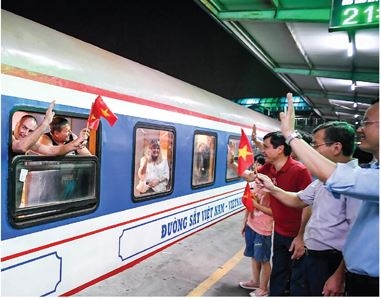After years of being seen as lagging behind in infrastructure, Vietnam’s railway sector is now entering a new phase of revival. The rollout of culturally-themed tourist trains and the embrace of modern technology are not only giving the industry a fresh look but also reinforcing its place in the nation’s transport network.
Bold revival
The Vietnam Railways Corporation (VRC) launched the “Hanoi Five City Gates” train and a biometric ticket control system at Hanoi Railway Station on August 19, as part of 250 projects that were inaugurated or saw ground broken nationwide on the day to mark the 80th anniversary of the August Revolution (August 19) and National Day (September 2). More than just the launch of new products, it marked a bold statement from the railway sector about its determination to regain momentum and reassert its place in the era of integration.
The special train evokes a thousand years of heritage through familiar names such as O Quan Chuong, O Cau Den, O Cau Giay, O Cho Dua, and O Dong Mac. Each carriage is designed as more than just a travel space, and feature spacious double-deck seating, panoramic windows for sightseeing, and interiors with their own themes that turn the journey into a moving “cultural exhibition”. Along the way, passengers can immerse themselves in traditional Vietnamese performing arts, including “quan ho”, “ca tru”, “hat xam”, and “cheo”.
Beyond image revamps, the rollout of biometric ticketing marks a major leap in the sector’s digital transformation. Instead of scanning QR codes, passengers simply tap their chip-based ID cards, reducing check-in time by half while significantly improving transparency and security. Looking ahead, the system will integrate with the VNeID platform, allowing electronic ID boarding and paving the way for smart stations. This reflects the sector’s commitment to implementing Politburo Resolution No. 57-NQ/TW on infrastructure development and digital transformation.
“With unity, creativity, and the courage to innovate, the railway sector will continue to affirm its role as the backbone of the national transport system, while contributing to a sustainable, green, and modern future for the country,” Mr. Hoang Gia Khanh, General Director of VNR, emphasized at the launch.
Ms. Nguyen Thi Hoa Mai, Deputy Director of the Vietnam National Tourism Administration, highlighted that the Hanoi Five City Gates train is a unique model that blends rail, heritage, and art. It not only enriches Hanoi’s tourism offerings but also strengthens regional connectivity, spreading cultural and economic values to neighboring localities.
Several cultural-themed tourist trains have been introduced in recent years, such as the “Connecting Central Heritage” train, the Red Flamboyant train in northern Hai Phong city, and premium services linking Hanoi with central Quang Tri province. What they share in common is a strategic choice: instead of competing head-on with budget airlines or expressways, they carve out a niche market that emphasizes culture, tourism, and experiential value. In other words, the railway sector is turning limitations into advantages, prioritizing identity over speed while using technology to enhance the journey.
On track for a new chapter
For Vietnam’s railway sector to truly reclaim its backbone role in transport, a sweeping overhaul of infrastructure, technology, and operating models is essential. The sector now stands at a decisive crossroads, where the rollout of flagship projects will define its place in the decades ahead.
Urban railway networks are gradually taking shape in Hanoi and Ho Chi Minh City. The capital’s Cat Linh - Ha Dong metro line, after more than two years in operation, now carries an average of over 35,000 passengers a day; a clear sign of its potential to reshape commuting habits. The Nhon - Hanoi Station metro line is also being fast-tracked, with the elevated section expected to open by 2027.
In the southern city, meanwhile, Metro Line No. 1 (Ben Thanh - Suoi Tien) has been completed, raising expectations that the metropolis will finally step into the era of mass public transit. The metro project is viewed as a critical test of rail’s ability to reclaim its central role in moving urban passengers.
At the national level, the 1,541-km North-South high-speed railway line has already been approved by the National Assembly. The government and local authorities are now pushing forward with land clearance and feasibility studies, aiming to begin work on priority sections - Hanoi to Vinh and Ho Chi Minh City to Nha Trang - between 2026 and 2030. If realized, this “infrastructure revolution” could cut travel time between the two ends of the country to just six hours, while spurring growth in logistics, tourism, and investment.
Rail’s ambitions also extend beyond national borders. Plans are moving ahead for the Lao Cai - Hanoi - Hai Phong international line, which would directly link with China’s rail network. Once operational, it will create a vital freight corridor from southwest China to northern Vietnam’s ports, positioning the country as a key transit hub for the Greater Mekong Subregion. Meanwhile, a proposed rail link between Long Thanh and Tan Son Nhat International Airports in Ho Chi Minh City and nearby is being studied to better synchronize the country’s largest aviation infrastructure.
Together, these projects indicate a strong resurgence for Vietnam’s railway sector. To ensure a true rebirth will require more than political commitment, however, it will also require the backing of local governments, the engagement of businesses, and the support of society as a whole.
Full steam ahead
When viewed in the broader context of national infrastructure, the railway sector’s greatest challenge is resources. The North-South high-speed line alone is expected to cost more than $67 billion, not counting urban and cross-border projects. The State budget is unable to cover such costs, while official development assistance (ODA) and public-private partnership (PPP) financing need transparent, attractive, and tailored mechanisms. Unlocking capital is therefore the first hurdle to be cleared if plans are to move from the drawing board to reality.
Human resources pose the next obstacle. High-speed and metro lines demand tens of thousands of skilled engineers, specialists, and technicians. Yet most of Vietnam’s current workforce is still accustomed to the outdated 1,000 mm gauge system and has limited exposure to modern technologies. Without immediate focus on training, international cooperation, and technology transfer, the country risks building railways without the people to run them.
Technology choices add another layer of complexity, as the necessary technology must be advanced, financially viable, and suited to Vietnam’s terrain.
The role of domestic enterprises, particularly the VRC, is also under scrutiny. Can it spearhead this transformation, or will stronger participation from private groups and international investors be needed? The answer will help redefine the place of State-owned enterprises (SOEs) in Vietnam’s infrastructure landscape.
In the era of deep integration, the railway sector also carries a broader mission: green development. As Vietnam commits to net-zero emissions by 2050, no other transport mode can match rail in reducing emissions and promoting social equity. Freight trains linking ports with industrial hubs and passenger lines connecting regions would transport not only goods and people but also the vision of a more sustainable and inclusive future.
More than a century ago, Vietnam’s first trains reshaped the nation. Today, in the age of globalization, the railway is once again being called upon to fulfill a historic mission, not only to revive an industry but to power integration, drive sustainable growth, and position a modern, confident Vietnam on the tracks of progress.









 Google translate
Google translate